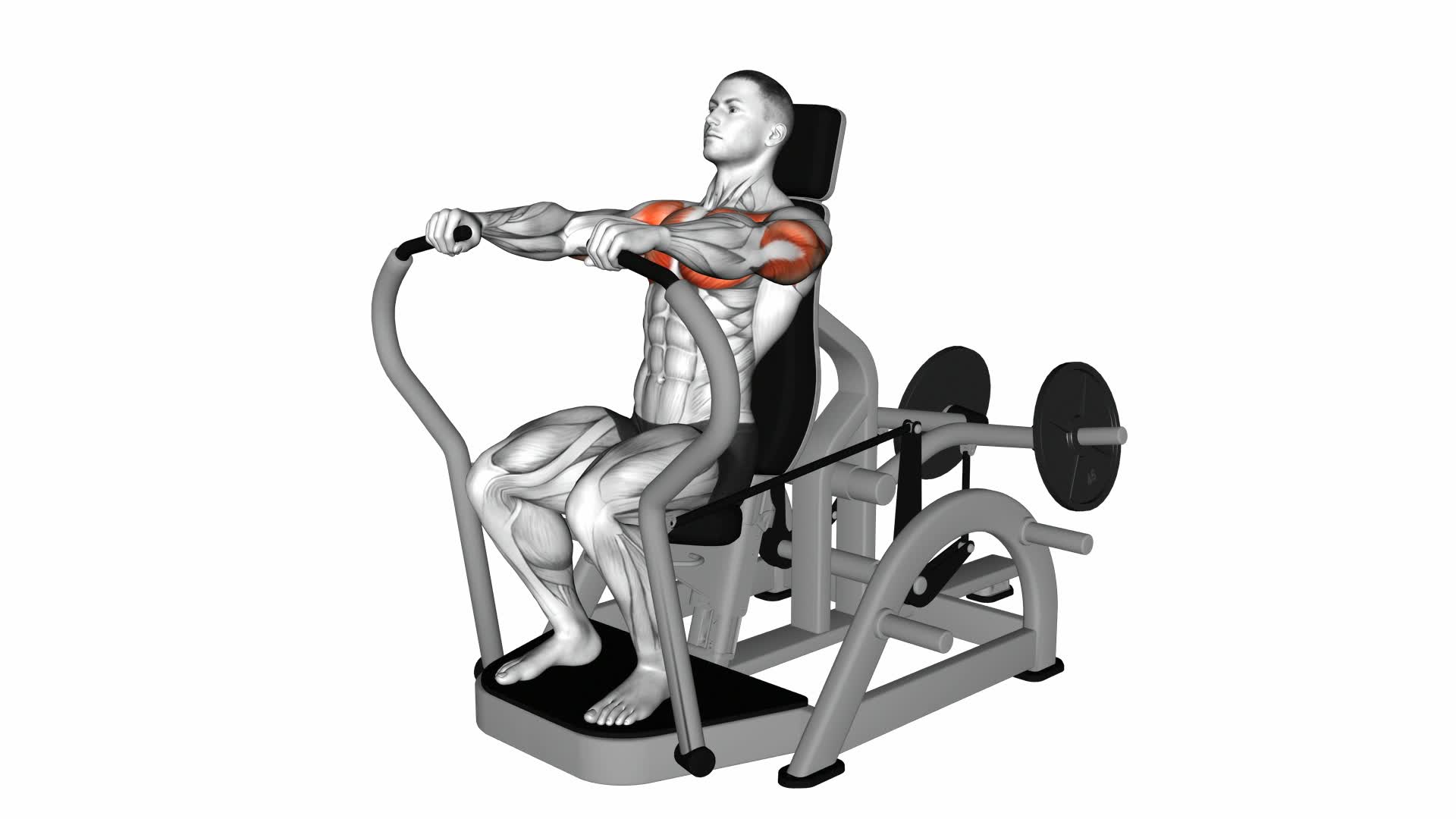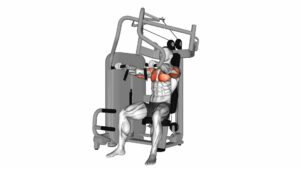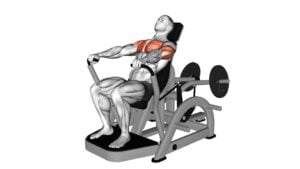Lever Chest Press (VERSION 4) – Video Exercise Guide & Tips

Looking to strengthen your chest muscles? Check out the Lever Chest Press (Version 4) – Video Exercise Guide & Tips. This article will provide you with expert advice on how to perform the exercise correctly, variations to challenge yourself, and tips for maximizing your results.
Watch This Exercise Video
With safety precautions and common mistakes to avoid, you'll be well-equipped to achieve your fitness goals. Get ready to take your chest workout to the next level!
Key Takeaways
- Lever Chest Press targets multiple muscle groups in the upper body, including chest, shoulders, and triceps.
- It promotes overall upper body strength and muscle development.
- Lever Chest Press improves muscle definition and size.
- Engaging core muscles and maintaining proper form and technique are crucial for maximizing results and preventing injuries.
Benefits of Lever Chest Press
Discover the numerous benefits of the Lever Chest Press for your upper body strength and muscle development.
Before starting any exercise, it's crucial to warm up properly. Warming up prepares your muscles and joints for the workout, reducing the risk of injury. Spend at least five to ten minutes performing dynamic stretches and light cardio exercises to increase blood flow and loosen up your muscles.
Once you're warmed up, it's important to focus on your breathing during the Lever Chest Press. Proper breathing technique enhances your performance and ensures you get the most out of each repetition. Inhale deeply before lowering the lever, and exhale forcefully as you push the lever away from your body. This controlled breathing helps stabilize your core and maintain proper form throughout the exercise.
The Lever Chest Press offers several benefits. It targets multiple muscle groups in your upper body, including the chest, shoulders, and triceps, promoting overall upper body strength. Additionally, it helps improve muscle definition and size, making it an effective exercise for muscle development.
Incorporating the Lever Chest Press into your workout routine can enhance your upper body strength, increase muscle mass, and improve your overall fitness level. Remember to warm up properly and focus on your breathing technique to maximize the benefits of this exercise.
Correct Form and Technique
To perform the Lever Chest Press correctly, position yourself on the machine with your feet flat on the ground and grip the handles firmly. Here's how to ensure proper form and technique:
- Keep your back straight and firmly press your back against the pad.
- Engage your core muscles by tightening your abdominal muscles.
- Bend your elbows and bring the handles towards your chest.
- Exhale as you push the handles away from your body, extending your arms.
- Inhale as you return to the starting position, keeping a controlled movement.
Avoid arching your back or using excessive momentum.
Maintain a slow and controlled pace throughout the exercise.
Focus on using your chest muscles to push the handles away, rather than relying on your shoulders or arms.
Remember to breathe properly throughout the exercise, inhaling during the eccentric phase and exhaling during the concentric phase.
Common misconceptions include locking out your elbows or using your legs to assist the movement. Avoid these mistakes to maximize the effectiveness of the exercise.
Variations and Modifications
What are some ways you can modify or vary the Lever Chest Press exercise?
There are several progression options and modifications that can be made to the Lever Chest Press to target different muscle groups and increase the intensity of the exercise.
One way to modify the exercise is by adjusting the resistance or weight used. By increasing the weight, you can challenge your muscles and promote muscle growth. Conversely, decreasing the weight can be helpful for beginners or individuals recovering from an injury.
Another variation is to change the grip width. By using a wider grip, you can target the outer chest muscles (pectoralis major) more effectively. On the other hand, a narrower grip will engage the triceps muscles to a greater extent.
Additionally, you can modify the exercise by adjusting the seat position. A higher seat position will place more emphasis on the upper chest, while a lower seat position will engage the lower chest muscles.
To increase muscle activation and challenge your stability, you can perform the Lever Chest Press on an unstable surface, such as a stability ball or a Bosu ball.
Tips for Maximizing Results
To maximize your results with the Lever Chest Press, focus on maintaining proper form and using a challenging weight that allows you to complete the desired number of repetitions with good technique.
Here are some tips to help you improve your muscle strength and enhance muscle definition:
- Engage your core: Before starting the exercise, activate your core muscles by pulling your belly button towards your spine. This will help stabilize your body and prevent excessive strain on your lower back.
- Control the movement: Slowly lower the weight towards your chest, taking about 2 seconds to do so. Pause for a second at the bottom of the movement, and then press the weight back up, taking about 2 seconds as well. This controlled tempo will maximize muscle activation and prevent momentum from taking over.
- Focus on the chest muscles: Throughout the exercise, concentrate on squeezing your chest muscles. Imagine that you're trying to bring your elbows together as you press the weight up. This mind-muscle connection will help you target the chest muscles more effectively.
Safety Precautions and Common Mistakes
Now let's delve into safety precautions and common mistakes when performing the Lever Chest Press exercise.
To prevent common injuries, it's crucial to warm up properly before starting this exercise. A proper warm-up routine should include dynamic stretches and light cardio to increase blood flow to the muscles and prepare them for the workout ahead. This will help reduce the risk of muscle strains or tears during the exercise.
Another safety precaution to keep in mind is maintaining proper form throughout the movement. It's important to keep your back flat against the pad, engage your core muscles, and avoid arching your back or lifting your hips off the seat. Failing to do so can lead to unnecessary strain on your lower back and increase the risk of injury.
Common mistakes to avoid during the Lever Chest Press exercise include using too much weight, which can compromise your form and put excessive strain on your muscles and joints. Make sure to start with a weight that allows you to perform the exercise with proper technique.
Additionally, avoid locking your elbows at the top of the movement, as this can strain the joints and increase the risk of injury. Keep a controlled and smooth motion throughout the exercise, focusing on the muscles being targeted.
Frequently Asked Questions
How Many Sets and Repetitions Should I Do When Performing the Lever Chest Press?
When performing the lever chest press, it's important to consider how many sets and repetitions to do. The number of sets and reps can vary depending on your goals and fitness level.
Different variations of the lever chest press offer unique benefits, such as targeting specific muscle groups or increasing overall strength.
To get the most out of this exercise, it's recommended to start with a moderate number of sets and repetitions and gradually increase as you become more comfortable and stronger.
Can I Use the Lever Chest Press Exercise to Target Specific Areas of My Chest?
Yes, you can use the lever chest press exercise to target specific areas of your chest. The lever chest press is a versatile exercise that allows you to adjust the position of your hands and body to emphasize different parts of your chest muscles.
Can I Perform the Lever Chest Press Exercise if I Have a Shoulder Injury?
If you have a shoulder injury, it's important to prioritize your recovery and avoid exercises that may aggravate the condition.
While the lever chest press exercise can be effective for targeting the chest, it may not be suitable for someone with a shoulder injury.
It's recommended to consult with a healthcare professional or a certified trainer who can provide modifications and alternative exercises that are safe and beneficial for your specific situation.
Can I Use Different Grip Positions When Performing the Lever Chest Press?
Yes, you can definitely use different grip positions when performing the lever chest press. This exercise allows for various grip techniques such as wide grip, close grip, and neutral grip. Each grip position targets different muscles in your chest and arms, providing a well-rounded workout.
The lever chest press itself is highly beneficial as it helps strengthen and tone your chest muscles, improves upper body strength, and enhances overall muscular endurance.
Is It Recommended to Use a Spotter When Doing the Lever Chest Press Exercise?
Using a spotter during strength training exercises has several benefits. They can provide assistance and ensure proper form, reducing the risk of injury. Additionally, a spotter can help you push beyond your limits, leading to better muscle engagement and gains.
If you're unable to use a spotter for the lever chest press, there are alternative exercises that target the chest muscles, such as dumbbell chest press or push-ups. However, it's recommended to have a spotter for safety and optimal results.
Conclusion
In conclusion, the lever chest press is a highly effective exercise for targeting the chest muscles. By maintaining correct form and technique, you can maximize your results and avoid common mistakes.
Additionally, incorporating variations and modifications can help challenge your muscles and prevent plateaus. Remember to prioritize safety by starting with a weight that's appropriate for your fitness level and gradually increasing the intensity.
Keep up the good work and enjoy the benefits of a strong and sculpted chest!

Author
Years ago, the spark of my life’s passion ignited in my mind the moment I stepped into the local gym for the first time. The inaugural bead of perspiration, the initial endeavor, the very first surge of endorphins, and a sense of pride that washed over me post-workout marked the beginning of my deep-seated interest in strength sports, fitness, and sports nutrition. This very curiosity blossomed rapidly into a profound fascination, propelling me to earn a Master’s degree in Physical Education from the Academy of Physical Education in Krakow, followed by a Sports Manager diploma from the Jagiellonian University. My journey of growth led me to gain more specialized qualifications, such as being a certified personal trainer with a focus on sports dietetics, a lifeguard, and an instructor for wellness and corrective gymnastics. Theoretical knowledge paired seamlessly with practical experience, reinforcing my belief that the transformation of individuals under my guidance was also a reflection of my personal growth. This belief holds true even today. Each day, I strive to push the boundaries and explore new realms. These realms gently elevate me to greater heights. The unique combination of passion for my field and the continuous quest for growth fuels my drive to break new ground.



